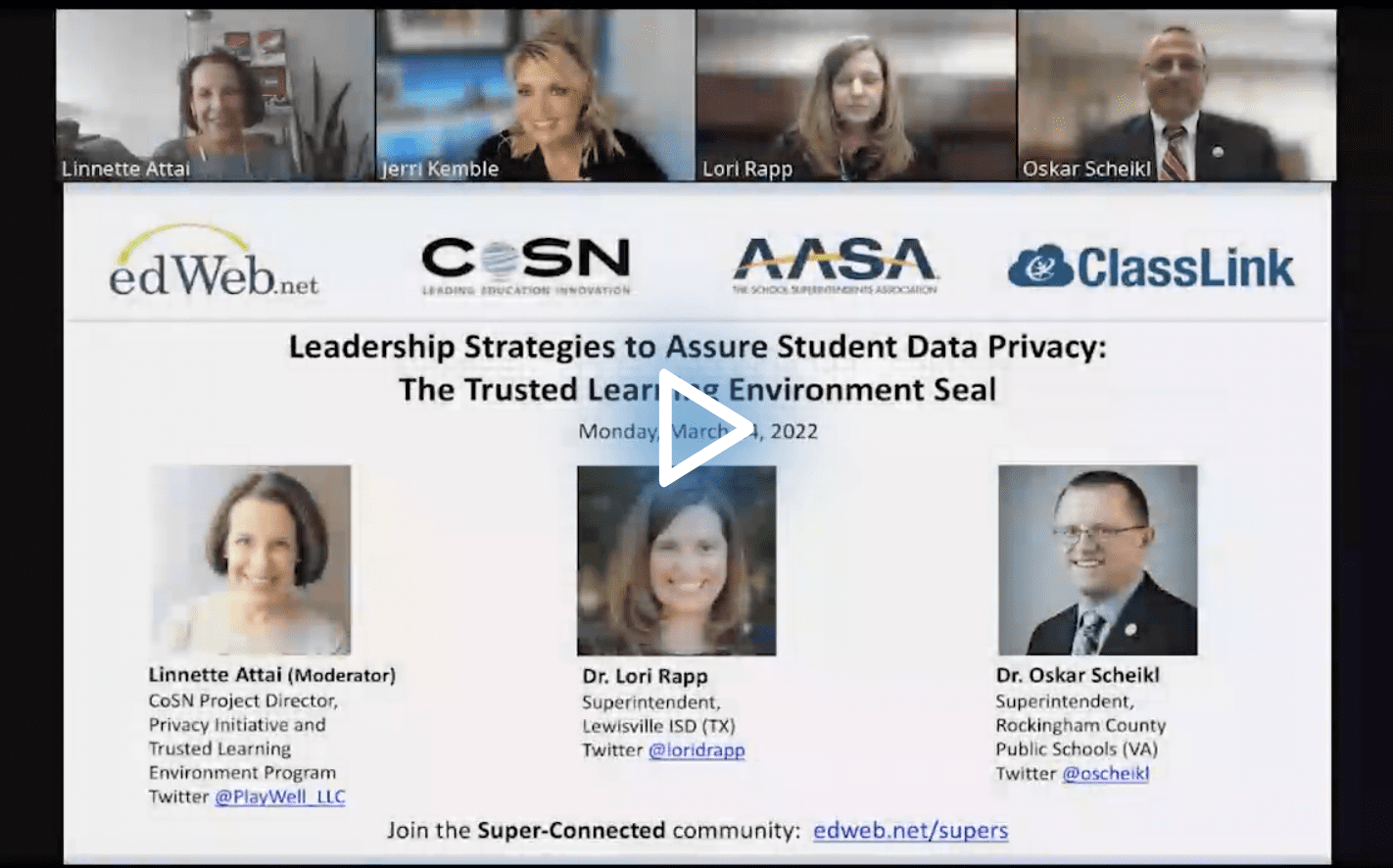5 Critical Guidelines for Student Data Privacy
Watch the Recording Listen to the Podcast
This edLeader Panel is presented by CoSN and AASA.
Sponsored by ClassLink
Teachers can no longer download any app they want and use it the same day—every piece of instructional technology must be vetted for how it relates to educational goals and checked against software the school already has. More important, though, every piece of technology must adhere to the district’s student data privacy policies.
During the edWebinar, “Leadership Strategies to Assure Student Data Privacy: The Trusted Learning Environment Seal,” the presenters explored CoSN’s Five Critical Guidelines for Ensuring Data Privacy in Your Use of Technology and how superintendents can support their staff.
1. Stay current and compliant with federal and state laws
While school counsel may have general knowledge of FERPA and other federal laws, most aren’t data privacy experts. That’s why the presenters recommended having a team, including counsel and the CTO, to monitor changes in the laws and how they impact school practices.
In addition, they suggested talking with other districts and working with education organizations to learn more about best practices. Rather than creating policies and compliance guidelines from scratch, start with what works and adapt it for your school.
2. Address community and stakeholder expectations early and often
Of course, administrators should be talking to and working with their educators and staff to understand school policies, but getting parent support is also essential. You might need to rethink all of your family documents from teacher presentations to handbooks to explain how your district protects student information. Talk to them and find out their concerns and update your outreach to address their questions.
Dr. Oskar Scheikl, Superintendent of Rockingham County Public Schools (VA), said that his district shares vendor information on its website and how they comply with data protection as well as the vendor’s own data privacy policy.
3. Keep instructional impacts in the picture
While the old system was to say yes to every teacher’s technology request, the new system could seem like a lot of nos. So, the presenters suggest starting with the end: Ask the teachers what the instructional goal is. Then, have the instructional tech team research whether any tech already purchased by the school meets that goal.
If not, help them find a tool that meets the goal and complies with the school’s data privacy policy. Have a clear approval process that moves in a timely manner so that teachers feel heard but the data isn’t compromised.
4. Responsible, responsive privacy administration and management mitigates RISK
Again, having a system that’s user friendly is key. And don’t just dump the system on the teachers—work with them to make sure that they understand why they need to submit requests and the reasons a request could be rejected. Remind them that this isn’t about saying no but about protecting the students.
Furthermore, make sure all administrators understand the system. They don’t need to have detailed technical knowledge, but they need to be able to explain why it’s needed.
5. Training. Training. Training.
Student data privacy is for all staff—no matter their role—and should happen multiple times a year. Both presenters said their districts offer a variety of training programs from in-person to online compliance courses to self-guided training.
Dr. Lori Rapp, Superintendent of Lewisville Independent School District (TX), said they even moved their instructional technology team out from the tech department and into teaching and learning so that both teams own and support the commitment to data privacy.
Finally, remember that training is resource intensive. It requires considerable effort to coordinate, especially when you are training students and families as well as educators.
Learn more about this edWeb broadcast, “Leadership Strategies to Assure Student Data Privacy: The Trusted Learning Environment Seal,” presented by CoSN and AASA, and sponsored by ClassLink.
Watch the Recording Listen to the Podcast
Join the Community
Super-Connected is a free professional learning community for school superintendents, district leadership, and aspiring district leaders.


ClassLink empowers your students and teachers with instant access to their learning resources. ClassLink® LaunchPad includes a library of over 6,000 single sign-on apps and instant links to file folders at school and on Google, Office 365, Dropbox, and Box cloud drives. ClassLink Roster Server easily and securely delivers class rosters to any publisher using open technology standards. ClassLink Analytics gives decision makers the usage data they need. ClassLink is ideal for 1 to1 and BYOD initiatives.
Blog post by Stacey Pusey, based on this edWebinar






Comments are closed.